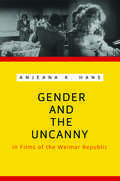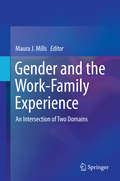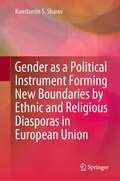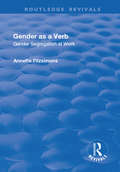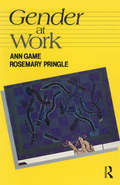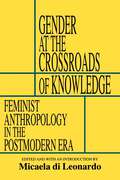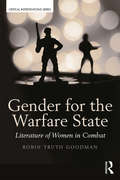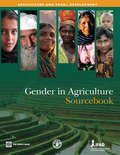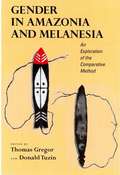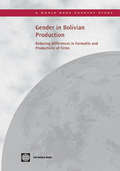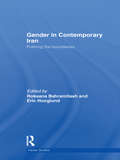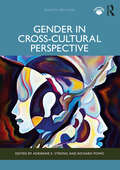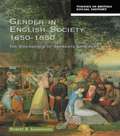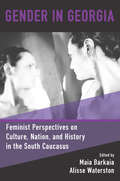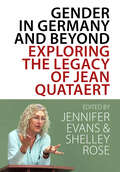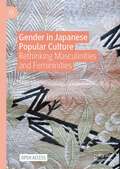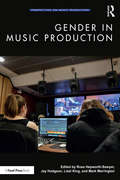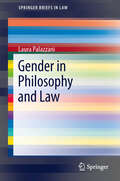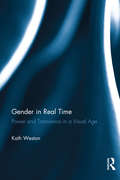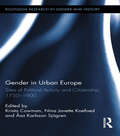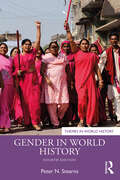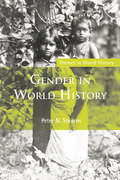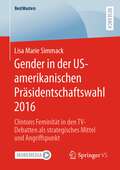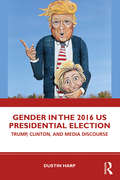- Table View
- List View
Gender and the Uncanny in Films of the Weimar Republic (Contemporary Approaches To Film And Media Ser.)
by Anjeana K. HansThe Weimar period in Germany was a time of radical change, when the traditions and social hierarchies of Imperial Germany crumbled, and a young, deeply conflicted republic emerged. Modernity brought changes that reached deep into the most personal aspects of life, including a loosening of gender roles that opened up new freedoms and opportunities to women. The screen vamps, garçonnes, and New Women in this movie-hungry society came to embody the new image of womanhood: sexually liberated, independent, and--at least to some--deeply threatening. In Gender and the Uncanny in Films of the Weimar Republic, author Anjeana K. Hans examines largely forgotten films of Weimar cinema through the lens of their historical moment, contemporary concerns and critiques, and modern film theory to give a nuanced understanding of their significance and their complex interplay between gender, subjectivity, and cinema. Hans focuses on so-called uncanny films, in which terror lies just under the surface and the emancipated female body becomes the embodiment of a threat repressed. In six chapters she provides a detailed analysis of each film and traces how filmmakers simultaneously celebrate and punish the transgressive women that populate them. Films discussed include The Eyes of the Mummy (Die Augen der Mumie Mâ, Ernst Lubitsch, 1918), Uncanny Tales (Unheimliche Geschichten, Richard Oswald, 1919), Warning Shadows (Schatten: Eine nächtliche Halluzination, Artur Robison, 1923), The Hands of Orlac (Orlacs Hände, Robert Wiene, 1924), A Daughter of Destiny (Alraune, Henrik Galeen,1928), and Daughter of Evil (Alraune, Richard Oswald, 1930). An introduction contextualizes Weimar cinema within its unique and volatile social setting. Hans demonstrates that Weimar Germany's conflicting emotions, hopes, and fears played out in that most modern of media, the cinema. Scholars of film and German history will appreciate the intriguing study of Gender and the Uncanny in Films of the Weimar Republic.
Gender and the Work-Family Experience
by Maura J. MillsConflict between work and family has been a topic of discussion since the beginning of the women's movement, but recent changes in family structures and workforce demographics have made it clear that the issues impact both women and men. While employers and policymakers struggle to navigate this new terrain, critics charge that the research sector, too, has been slow to respond. Gender and the Work-Family Experience puts multiple faces - male as well as female - on complex realities with interdisciplinary and cross-cultural awareness and research-based insight. Besides reviewing the state of gender roles as they affect home and career, this in-depth reference examines and compares how women and men experience work-family conflict and its consequences for relationships at home as well as outcomes on the job. Topics as wide-ranging as gendered occupations, gender and shiftwork, heteronormative assumptions, the myth of the ideal worker, and gendered aspects of work-family guilt reflect significant changes in society and reveal important implications for both research and policy. Also included in the coverage: Gender ideology and work-family plans of the next generation Gender, poverty, and the work-family interface The double jeopardy effect: the importance of gender and race in work-family research When work intrudes upon employees' personal time: does gender matter? Work-family equality: the importance of a level playing field at home Women in STEM: family-related challenges and initiatives Family-friendly organizational policies, practices, and benefits through the gender lens Geared toward work-family and gender researchers as well as students and educators in a variety of fields, Gender and the Work-Family Experience will find interested readers in the fields of industrial and organizational psychology, business management, social psychology, sociology, gender studies, women's studies, and public policy, among others. .
Gender as a Political Instrument Forming New Boundaries by Ethnic and Religious Diasporas in European Union
by Konstantin S. SharovThis book considers gender as a convenient tool for making new boundaries within the European Union. It offers a political analysis based on sociological surveys conveyed by the author in 2008–2021. It emphasises the utmost necessity of a proper understanding of specific gender political technologies applied in ethnic and religious diasporas within the EU borders, by EU ruling elites, to avoid ideological collapse in relations with diaspora political groups and general members. The book demonstrates that uncritical application of EU gender equality programs within diasporas may transform gender to a dangerous political force destabilising the European Union. The monograph will be of interest for political science researchers, legislators, and administrators that work with political dimension of gender.
Gender as a Verb: Gender Segregation at Work (Routledge Revivals)
by Annette FitzsimonsThis title was first published in 2002. Aiming to contribute to feminist theory in the area of paid employment, this volume demonstrates how the meanings attached to gender can form part of the explanation for the persistence of gender segregation at work. The author applies the Foucaultian concept of discourse to occupational segregation to offer a new approach to the study of gender segregation. An analysis is provided of gender in relation to computer programming.
Gender at Work
by Rosemary Pringle Ann GameThree themes are drawn together in this book: gender and sexuality, the organisation of work, and the impact of technological change. Their inter-relationship is explored in six area studies: manufacturing, banking, retailing, computing, nursing and housework.Gender at Work presents an account of how each area has changed since the Second World War; sets out ways in which the notion of what constitutes 'proper' work for men and women changes with new work processes; and analyses the prospects for, and limits of, sexual 'equality' in the workplace.Based on the first-hand observations of workers, reflecting on their work experience, this book allows workers to speak for themselves: they reveal the centrality of gender to the way capitalism is organised.'A notable contribution, both to feminist and labour studies in Australia and further afield. Every woman, whether at home or in the paid workforce, should read this book. It will help her assess exactly what she is - and should be - worth to the community, and how she can help to ensure her true evaluation.' - Newcastle Herald'A very readable book which makes a major theoretical and descriptive contribution to the analysis of gender in Australian Society.' - Journal of Industrial Relations'A convincing demonstration of the central place of gender in the work relationships between men and women. The insights it provides, into the underlying causes of the sex division of tasks and the way in which new jobs in any individual setting quickly become sex-typed, are important for any manager of a mixed workplace.' - Practising Manager
Gender at the Crossroads of Knowledge: Feminist Anthropology in the Postmodern Era
by Micaela Di LeonardoGender at the Crossroads of Knowledge brings feminist anthropology up to date, highlighting the theoretical sophistication that characterizes recent research. Twelve essays by outstanding scholars, written with the volume's concerns specifically in mind, range across the broadest anthropological terrain, assessing and contributing to feminist work on biological anthropology, primate studies, global economy, new reproductive technologies, ethno-linguistics, race and gender, and more. The editor's introduction not only sets two decades of feminist anthropological work in the multiple contexts of changes in anthropological theory and practice, political and economic developments, and larger intellectual shifts, but also lays out the central insights feminist anthropology has to offer us in the postmodern era. The profound issues raised by the authors resonate with the basic interests of any discipline concerned with gender, that is, all of the social sciences and humanities.
Gender for the Warfare State: Literature of Women in Combat (Critical Interventions)
by Robin Truth GoodmanGender for the Warfare State is the first scholarly investigation into the written works of U.S. women combat veterans in twenty-first century wars. Most recent studies quantify military participation, showing how many women participate in armed services and what their experiences are in a traditionally “male institution.” Many of these treatments regard women as victims solely of enemy fire, even as they are also often victims of their own military apparatus and of their own involvement in global aggression. By applying literary analysis to a sociological question, Gender for the Warfare State views women’s experiences through story and literary traditions that carry meaning into present practices. Goodman shows that women in combat are not just entering and being victimized in “male institutions,” but are also actively changing the story of gender and thus the structure of power that is constructed through gender. Moreover, this book unveils a new narrative of care that affects economic relations more broadly and the contemporary politics of the liberal social contract. Women’s participation in combat is not just a U.S. event but global and therefore has a deeper historical range than current sociological accounts imply. The book compares the political contexts of women’s entry into war now with their prior, twentieth-century contributions to wars in other cultural settings and then uses this comparison to show a variety of meanings at play in the gender of war.
Gender in Agriculture Sourcebook
by World Bank International Fund for Agricultural Development Food And Agriculture OrganizationThe 'Gender in Agriculture Sourcebook' provides an up-to-date understanding of gender issues and a rich compilation of compelling evidence of good practices and lessons learned to guide practitioners in integrating gender dimensions into agricultural projects and programs. It is serves as a tool for: guidance; showcasing key principles in integrating gender into projects; stimulating the imagination of practitioners to apply lessons learned, experiences, and innovations to the design of future support and investment in the agriculture sector. The Sourcebook draws on a wide range of experience from World Bank, Food and Agriculture Organization (FAO), International Fund for Agricultural Development (IFAD), and other donor agencies, governments, institutions, and groups active in agricultural development. The Sourcebook looks at: access to and control of assets; access to markets, information and organization; and capacity to manage risk and vulnerability through a gender lens. There are 16 modules covering themes of cross-cutting importance for agriculture with strong gender dimensions (Policy, Public Administration and Governance; Agricultural Innovation and Education; Food Security; Markets; Rural Finance; Rural Infrastructure; Water; Land; Labor; Natural Resource Management; and Disaster and Post-Conflict Management) and specific subsectors in agriculture (Crops, Livestock, Forestry, and Fisheries). A separate module on Monitoring and Evaluation is included, responding to the need to track implementation and development impact. Each module contains three different sub-units: (1) A Module Overview gives a broad introduction to the topic and provides a summary of major development issues in the sector and rationale of looking at gender dimension; (2) Thematic Notes provide a brief and technically sound guide in gender integration in selected themes with lessons learned, guidelines, checklists, organizing principles, key questions, and key performance indicators; and (3) Innovative Activity Profiles describe the design and innovative features of recent and exciting projects and activities that have been implemented or are ongoing.
Gender in Amazonia and Melanesia: An Exploration of the Comparative Method
by Thomas A. Gregor Donald TuzinThe contributors to this innovative volume illuminate the various ways in which sex and gender are elaborated, obsessed over, and internalized, shaping subjective experiences common to entire cultural regions, and beyond.
Gender in Bolivian Production: Reducing Differences in Formality and Productivity of Firms
by Trine Lunde Yaye Sakho Maria Arribas-BanosBolivia's informal economic sector is the largest in Latin America, and women-owned businesses tend to be overrepresented in the informal sector and to be less profitable than firms in the formal sector. This study seeks to better understand gender-based differences in firms' tendencies toward formality, the impact of formality on profits, and the productivity of small informal firms. Using data from firm surveys, national household surveys, and qualitative data from focus groups, the study conducts a gender analysis of formality and productivity in six different sectors in Bolivia. The findings shed new light on how gender-based differences contribute to a firm's decision to become formal and the consequences of this decision for profitability. The outcomes of the study suggest that policies should focus on increasing the productivity and scale of women-owned businesses. Two general priorities emerge: promoting women's access to productive assets to facilitate growth and productivity and providing an enabling environment for women's entrepreneurship by expanding women's choices and capacity to respond to market opportunities.
Gender in Contemporary Iran: Pushing the Boundaries (Iranian Studies)
by Roksana Bahramitash Eric HooglundThis book examines gender and the dynamics of social change in contemporary Iran, documenting the changes in women’s lives and showing how women have now become agents of social change rather than victims. Bringing together the detailed primary research of a number of eminent scholars working in Iran, this collection provides unique perspectives on the past decade in Iranian society. Chapters document and examine how different Iranian groups and classes are negotiating, resisting, and pressing for political and social change, to explore the complexity of a society that often is portrayed in monolithic stereotypes in the international media. Thematically arranged sections explore discourses around gender and the impact of these discourses on women; the gendered impact of educational, employment, communications, and cultural changes; changing gender attitudes among the post-revolutionary generation of youth; and the ways economic changes have been affecting women. Providing an important basis for understanding social and political developments in a country that has been a focus of international attention for much of the last decade, this collection will be an important reference for scholars of Iranian studies, gender studies, political science and sociology.
Gender in Cross-Cultural Perspective
by Adrienne E. Strong Richard PowisThis fully updated new edition of Gender in Cross-Cultural Perspective carefully introduces and responds to changes in anthropological approaches to and perspectives on gender. With two new editors and new authors from the Global South and underrepresented communities, it combines theoretically and ethnographically based chapters to examine gender roles and ideology around the world.The books is divided thematically into five parts, with the editors opening each section with a succinct introduction to the principal issues. The book retains some of the classic chapters while offering new contributions and extended discussions throughout on methodology. It also has entirely new contributions that reflect more recent developments in the discipline, including more emphasis on LGBTQ+ communities, COVID, and migration. This new edition also features additional support for teaching and learning, including a film list and discussion questions, that are now offered as supplemental online materials.The eighth edition of Gender in Cross-Cultural Perspective continues to be an essential resource for undergraduate and graduate students encountering the anthropology of gender for the first time.
Gender in English Society 1650-1850: The Emergence of Separate Spheres? (Themes In British Social History)
by Robert B. ShoemakerA lively social history of the roles of men and women - from workplace to household, from parish church to alehouse, from market square to marriage bed. Robert Shoemaker investigates such varied topics as crime, leisure, the theatre, religious observance, notions of morality and even changing patterns of sexual activity itself.
Gender in Georgia: Feminist Perspectives on Culture, Nation, and History in the South Caucasus
by Alisse Waterston Maia BarkaiaAs Georgia seeks to reinvent itself as a nation-state in the post-Soviet period, Georgian women are maneuvering, adjusting, resisting and transforming the new economic, social and political order. In Gender in Georgia, editors Maia Barkaia and Alisse Waterston bring together an international group of feminist scholars to explore the socio-political and cultural conditions that have shaped gender dynamics in Georgia from the late 19th century to the present. In doing so, they provide the first-ever woman-centered collection of research on Georgia, offering a feminist critique of power in its many manifestations, and an assessment of women's political agency in Georgia.
Gender in Germany and Beyond: Exploring the Legacy of Jean Quataert
by Jennifer V. Evans and Shelley E. RoseJean Quataert redefined the boundaries of at least five historical fields including European socialism, women’s history and gender history, and international law and human rights. In this volume dedicated to her pioneering work, established and emerging scholars showcase the signature ways in which Quataert, as one of the discipline’s first women’s historians, has influenced how subsequent generations think about history writing as a form of intellectual activism. Gender in Germany and Beyond presents cutting edge historiographical commentary alongside new work which address subjects such as the history of German colonialism and women’s colonial leagues, human rights advocacy during the Cold War, and the complexities of turn of the century gay and lesbian rights organizing.
Gender in Japanese Popular Culture: Rethinking Masculinities and Femininities
by Sirpa SaleniusThis open-access essay collection brings together a range of viewpoints on gender from a diverse group of international scholars based in Finland, Belgium, Japan, Singapore, and Australia. The focus is, in particular, on gender performativity and non-binary or non-normative gender. The essays examine the ways in which gender can be depicted, perceived, and understood in Japanese popular culture. The work will be of interest to scholars working in gender studies, Asian studies, and popular culture. It will also act as a source text for higher education courses in Asia, Europe, and the United States.
Gender in Music Production (Perspectives on Music Production)
by Jay Hodgson Russ Hepworth-Sawyer Mark Marrington Liesl KingThe field of music production has for many years been regarded as male-dominated. Despite growing acknowledgement of this fact, and some evidence of diversification, it is clear that gender representation on the whole remains quite unbalanced. Gender in Music Production brings together industry leaders, practitioners, and academics to present and analyze the situation of gender within the wider context of music production as well as to propose potential directions for the future of the field. This much-anticipated volume explores a wide range of topics, covering historical and contextual perspectives on women in the industry, interviews, case studies, individual position pieces, as well as informed analysis of current challenges and opportunities for change. Ground-breaking in its synthesis of perspectives, Gender in Music Production offers a broadly considered and thought-provoking resource for professionals, students, and researchers working in the field of music production today.
Gender in Philosophy and Law
by Laura PalazzaniThis book is an introductory systematic framework in the complex and interdisciplinary sex/gender debate, focusing on philosophy of law.The volume analyses the different theories that have dealt with the gender category, highlighting the conceptual premises and the arguments of the most influential theories in the debate, which have had repercussions on the field of the ethical and juridical debate (with reference to intersexuality, transsexualism, transgender, homosexuality). The aim is to offer a sort of conceptual orientation in the complexity of the debate, in an effort to identify the various aspects and development processes of the theories, so as to highlight the conceptual elements of the theorisations to grasp the problem areas within them. It is therefore an overall synthetic and also explicative analysis, but not only explicative: the aim is to outline the arguments supporting the different theories and the counter-arguments too, for the purpose of proposing categories to weigh up the elements and to take one's own critical stance, with a methodological style that is neither descriptive nor prescriptive, but critical.
Gender in Real Time: Power and Transience in a Visual Age
by Kath WestonFirst published in 2003. Routledge is an imprint of Taylor & Francis, an informa company.
Gender in South Asia: Social Imagination and Constructed Realities
by Subhadra Mitra ChannaThis book is an examination of gender in South Asia and its intersection with other social variables like caste and class. It spans a wide canvas in terms of different social classes, ranging from elite to Dalit women of India, and takes material from ancient texts and modern media, literature and ethnographic materials forming a historical discourse. There is an appraisal of what feminism means in the Indian context and the cross-cultural construction of patriarchy that varies in its manifestations across time and space. The readers are taken on a journey that shows how gender can only be understood in its social and historical context and as a dynamic and performative concept that emerges out of both collective imaginations and social realities. The use of descriptive and narrative style makes the book readable and enjoyable to both academic and non-academic readers.
Gender in Urban Europe: Sites of Political Activity and Citizenship, 1750-1900 (Routledge Research in Gender and History #19)
by Krista Cowman Åsa Karlsson Sjögren Nina Javette KoefoedThis volume offers an integrated set of local studies exploring the gendering of political activities across a variety of sites ranging from print culture, courts, government and philanthropic bodies and public spaces, outlining how a particular activity was constituted as political and exploring how this contributed to a gendered concept of citizenship. The comparative and transnational perspectives revealed through combining such work contributes to establishing new knowledge about the relationship between gender, citizenship and the development of the modern town in Northern Europe.
Gender in World History (Themes in World History)
by Peter N. StearnsGender in World History integrates gender history and world history by dealing with significant global changes over time, regional patterns of gender relations, and the results of interregional contact on gender roles and concepts. Now in its 4th edition, this volume explores the rise of patriarchal gender systems and, in more modern history, the gradual and checkered decline of these systems. In addition to the roles of agriculture and then industrialization in shaping gender relations, the book deals with the impact of major religions, imperialism and decolonization, and human rights movements in more recent history. Regional coverage includes East Asia, South Asia, the Middle East and Mediterranean, Sub-Saharan Africa, Europe and the Americas. The book seeks to show how major patterns and changes in the past shed light on current gender issues in many world regions, enabling students to understand how gender roles have varied across the world and over time. This new edition also includes: More material on several societies, particularly in Asia and the Middle East Greater attention on historical and comparative assessment of sexual identities A focus on basic features of gender configurations Discussions of more recent human rights movements Providing a global but succinct overview of the history of gender throughout the world, Gender in World History remains essential reading for students of world history and gender studies.
Gender in World History (Themes in World History)
by Peter N. StearnsCovering societies from classical times to the twenty-first century, Gender in World History is a fascinating exploration of what happens to established ideas about men, women, and gender roles when different cultural systems come into contact. The book breaks new ground to facilitate a consistent approach to gender in a world history context. Now in its third edition, the book has been thoroughly updated, including: expanded treatment of Africa under Islamic influence expanded discussion of southeast Asia a new chapter on contemporary Latin America representations of individual women engagement with recent work on gender history and theory. With truly global coverage, this book enables students to understand how gender roles have varied across the world and over time, and the vital role of gender in structuring social and political relationships. Providing a succinct, current overview of the history of gender throughout the world, Gender in World History remains essential reading for students of world history.
Gender in der US-amerikanischen Präsidentschaftswahl 2016: Clintons Feminität in den TV-Debatten als strategisches Mittel und Angriffspunkt (BestMasters)
by Lisa Marie SimmackIn einer stark männlich geprägten US-amerikanischen Politik trat Hillary Clinton 2016 als erste aussichtsreiche weibliche Präsidentschaftskandidatin an. Ihr Gegenkandidat Donald Trump nahm dies zum Anlass, im Wahlkampf wiederholt mit diffamierenden, oft sexistischen Kommentaren auf sich aufmerksam zu machen. Gender und konkret Hillary Clintons Feminität rückten damit in den Vordergrund des polarisierenden und feindseligen Wahlkampfes. Clinton stand in drei TV-Duellen ihrem Kontrahenten gegenüber und versuchte, die Bürger*innen von ihren Kompetenzen als Frau für das höchste politische Amt der USA zu überzeugen. Studien zu Wahlverhalten zeigen, dass die Entscheidung der Wähler*innen am Tag der Wahl nicht bloß davon abhängt, welche Argumente und Positionen die Politiker*innen in den Debatten anführen und vertreten. TV-Duelle nehmen verstärkt eine zentrale Rolle für den Ausgang der Wahlen ein. Dieses Buch analysiert den Genderaspekt (konkret Clintons Feminität) in den drei TV-Debatten und untersucht, inwiefern Clintons Weiblichkeit von Trump als Nachteil dargestellt, von Clinton selbst jedoch als Vorteil genutzt wurde, um rhetorisch zu punkten. Hierzu werden die Debatten- und Kommunikationsstrategien der beiden Politiker*innen systematisch analysiert.
Gender in the 2016 US Presidential Election: Trump, Clinton, and Media Discourse (Global Gender)
by Dustin HarpUsing a discourse analysis, Dustin Harp investigates media during the 2016 US presidential election to explore how traditional (patriarchal) and feminist ideas about gender played out during the campaign. The book illustrates how these two ideologies competed for space and struggled for discursive authority. A broad range of media texts is examined, and "gender moments," where gender became a dominant part of the political conversation, are identified. These include the "nasty woman" and "grab them by the pussy" comments of Donald Trump and the "woman card" played by, and against, Hillary Clinton. Furthermore, Harp reveals how binary notions of gender and stereotypical ideas of how men and women should behave, look, and sound structured the ways Donald Trump and Hillary Clinton were talked about in the media. As a counterpoint, the research also shows the ways feminist ideologies worked against the sexism and misogyny and became mainstream in media discourse during the campaign. Students and researchers of Gender Studies will find that the "gender moments" in Gender in the 2016 US Presidential Election tell a broader story about women, gender expectations, and power. They offer important and timely insights about misogyny and sexual harassment in contemporary US culture and feminist resistance in a mediated public sphere.
